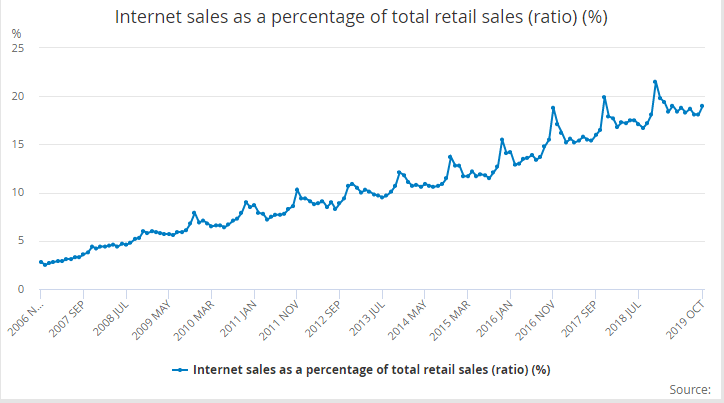Direct to consumer (D2C) is the latest buzzword in the retail industry, and with good reason.
High street stores are closing at an alarming rate, eCommerce marketplaces are thriving, and customers are becoming increasingly motivated by personalised brand experiences.
D2C commerce enables traditional manufacturers to take advantage of this current state of retail by selling directly to consumers and cutting out the middleman. But is D2C the future of retail or just a fad? Today, we’re finding out.
.
The growth of D2C
Physical retail stores are closing at an alarming rate. This year alone, an estimated 6,000 retail stores ceased trading, causing a significant gap in the high street and a growing gap in orders for manufacturers.
.
Meanwhile, the eCommerce industry is booming. Online sales currently account for 19% of all retail sales – a figure that’s consistently growing year-on-year.
.

(Source: ONS)
.
As part of this growth, we’ve seen the emergence of many successful digitally native vertical brands (DNVBs) – manufacturers selling D2C solely online.
.
But brands such as Dollar Shave Club, Casper and Gymshark haven’t only demonstrated the potential for DNVBs. Their D2C business model shows that you no longer need a “middleman” to successfully launch a product, reach customers or build a brand.
.
And brands want in. According to recent reports, 48% of manufacturers are racing to build DTC channels and connect with their customers directly online.
.
The benefits of D2C
So what are the benefits of selling D2C? The main perks of a direct to consumer strategy are control, profits and ownership.
.
Control – over your brand, pricing, supply chain and customer experience.
Profits – cutting out the middleman fees.
Ownership – owning the customer relationship and market data.
.
Beyond the three main benefits, there are many more advantages of selling D2C, including:
.
Reach – unlimited reach to potential customers
Personalisation – the ability to personalise products and experiences
Protection – protecting your brand against poor custmoer services or unethical retailers
Loyalty – enhanced opportunities to build direct customer relationships
Customer access – comprehensive access to customers and their data
Pricing – full control over pricing
Merchandising – complete control over merchandising and marketing
Speed to market – quicker routes to market
CAPEX – lower start-up costs
Overheads – fewer overheads.
.
In other words – more reach, smaller overheads.
.
The future of D2C
Will this rise last? We certainly think so.
The face of retail is changing as we know it and brands who aren’t adapting risk losing out. Will the traditional retail model completely disappear? No one knows, but do you want to risk finding out?
Intrigued about D2C?
If you’d like to know more about direct-to-consumer commerce and how you can integrate Amazon with your existing retail systems, get in touch with our enterprise team today at [email protected]



